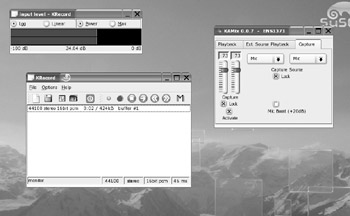Recording Audio
If you have a microphone, you can record your own music using your PC. You can e-mail voice messages to relatives overseas, for example, or capture yourself strumming your guitar!
In addition to this, most PC sound cards have line-in inputs to which you can attach a variety of domestic equipment. For example, by attaching your cassette recorder, you can digitize your old pre-CD tape collection. If your record player or audio amplifier has a line-out, you can transfer your old vinyl records.
SUSE Linux includes a quite sophisticated sound-recording program called KRecord, seen in Figure 19-7. To run this program, select K ® Multimedia ® Sound Recorder. It's a little like Windows' Sound Recorder program, but with a lot more functions.

Figure 19-7. KRecord is a powerful little program that can record audio from a microphone, line-in, or another source. If necessary, you can use KAMix to set input sound levels.
To record from a microphone, start by plugging the microphone into the relevant socket. (Most PC microphones and sound cards are color-coded; the microphone socket and jack are usually pink.)
Once it's plugged in, start KRecord. The next step is to make sure that the microphone's input level is set correctly, so select Options ® Input Level. This will show a VU meter-style graph of the incoming sound levels. Try speaking into the microphone. With any luck, the VU meter should respond, and rise and fall to the sound of your voice.
If nothing appears to be happening, or if the rise and fall is very minor, select Options ® Run Mixer. This will bring up KAMix, which in addition to controlling volume levels also lets you set the input sound levels. Click the Capture tab (to the very right of the program window) and ensure that Mic is selected in the drop-down lists, as shown in Figure 19-7. Then click and drag the Capture sliders and speak into the microphone, dragging the sliders until you reach an acceptable level of input. If this seems impossible, try putting a tick in the Mic Boost box.
Once the levels have been set, click the red record icon on the toolbar of KRecord. When you've finished speaking, click the Stop button.
| Caution | Any recording you make will be uncompressed audio. This will rapidly fill up your hard disk, since one minute of audio will roughly equate to 10MB of disk space! |
KRecord works on the concept of buffers. Every time you make a recording, it's held in a buffer and must be deliberately saved to disk or it will be lost when the program is quit. To save it, simply highlight it in the program window (if it's not already highlighted), and then choose File ® Save Buffer As.
Once you've recorded the audio to disk, you can use the instructions provided earlier in this chapter to turn it into an Ogg file. This will make it smaller but without losing any discernable audio quality.
Recording using the line-in of your sound card is virtually identical to recording from a microphone. The only difference is that you select the Line In option in the drop-down list in KAMix and adjust the levels so that they're appropriate.
As you might expect, powerful audio-editing and music-making programs run under Linux. However, these are specialized tools and not commonly found in most distros.
As usual, there are many programs available for each task, but perhaps one of the best audio editors is Audacity. This can be found at http://audacity.sourceforge.net/ and is also included on the SUSE Linux installation DVD-ROM (just search for it using the software section of YaST2). Audacity can perform simple tasks, such as recording, playing, importing, and exporting sounds. It also comes with a wide variety of effects (including the ability to use professional-level VST and LADSPA plug-ins). Additionally, it features an amplitude envelope editor, customizable spectrogram mode, and much more.
If you want to make music using MIDI (using your sound card's wave table sounds), many consider MusE to be one of the best programs for the task. It features audio and MIDI sequencing—effectively a complete recording studio running under Linux. For more details, visit http://lmuse.sourceforge.net/. This program is also included on the SUSE Linux DVD-ROM.
EAN: 2147483647
Pages: 293
- ERP Systems Impact on Organizations
- The Second Wave ERP Market: An Australian Viewpoint
- Enterprise Application Integration: New Solutions for a Solved Problem or a Challenging Research Field?
- The Effects of an Enterprise Resource Planning System (ERP) Implementation on Job Characteristics – A Study using the Hackman and Oldham Job Characteristics Model
- Relevance and Micro-Relevance for the Professional as Determinants of IT-Diffusion and IT-Use in Healthcare
- Chapter IV How Consumers Think About Interactive Aspects of Web Advertising
- Chapter VIII Personalization Systems and Their Deployment as Web Site Interface Design Decisions
- Chapter X Converting Browsers to Buyers: Key Considerations in Designing Business-to-Consumer Web Sites
- Chapter XI User Satisfaction with Web Portals: An Empirical Study
- Chapter XVIII Web Systems Design, Litigation, and Online Consumer Behavior